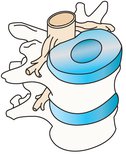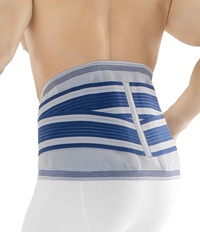Slipped Disc
Supporting ourselves with a strong core
Slipped disc, lumbago, general back ache: When your back is aching, everyday life can become a major burden.
An example of how a slipped disc occurs: The furniture has already been moved and there are only a few moving boxes left. One wrong move and a sharp pain shoots right down to the legs. This might be a slipped disc. This occurs when the soft part inside the spinal disc breaks through the outer fibrous ring.
But what do Spinal Discs do?
The spinal discs lie between our vertebrae like a cushion. They act like shock absorbers that not only absorb shocks but also balance unilateral movements. Their elasticity is heavily affected by the body’s water balance. When sitting down for long periods during the day or moving unilaterally, for example, the fluid gets squeezed out of the spinal discs. Throughout the day, a body can lose up to two centimetres of height from this process. The spinal discs only regain fluids through extended periods of lying down during the night. We can imagine this process by thinking of it like a wrung-out sponge: If you put it back into the water, it will soak it up water again and thereby gain thickness and elasticity.


Causes of a Slipped Disc
A slipped disc usually occurs in the area of the cervical spine or in the lower back, as the spine is inherently curved here and therefore more vulnerable. If the vertebrae experience the wrong type of strain over a long period, for example when sitting or standing for a long time, the liquids can be squeezed out of the spinal discs.
Age also has an effect on our spinal discs. The older you get, the less effective your discs become at absorbing water. As a result of this degeneration, the shock absorber stops functioning and presses onto the surrounding nerves or spinal cord. Symptoms include acute pain, numbness, and tingling.
Excess weight, a lack of exercise, and heavy physical work can all be contributors to a slipped disc. Normally, the abdominal and back muscles stabilise the spine. If these muscles are not exercised, however, the discs experience additional stress.
As in our example of moving boxes above, even a wrong move can lead to pain, limited mobility, and in the worst case, a slipped disc.
Treatment for a Slipped Disc
In some cases, a slipped disc can be resolved with a suitable bandage. In other cases, the escaped fluid must be pushed back into the core of the spinal disc during surgery.
Targeted training to build up muscles in the back and abdominal area can relieve pain, too. Physiotherapy should be prescribed by a doctor and precisely tailored to the requirements of the patient. This is why a distinction is made between active and passive physiotherapy – depending on whether the patient is able to perform the relevant movements independently or whether the treatment takes place with the aid of a therapist.
In addition to this, strong back muscles as well as gentle movements are the most important factors in preventing a further slipped disc. By doing sufficient and varied physical exercise, you can build up muscles in a targeted manner. But you can even do something good for your back at your workplace – for example, by taking a break to do exercises that loosen up your body now and then, or by using an ergonomic chair.



